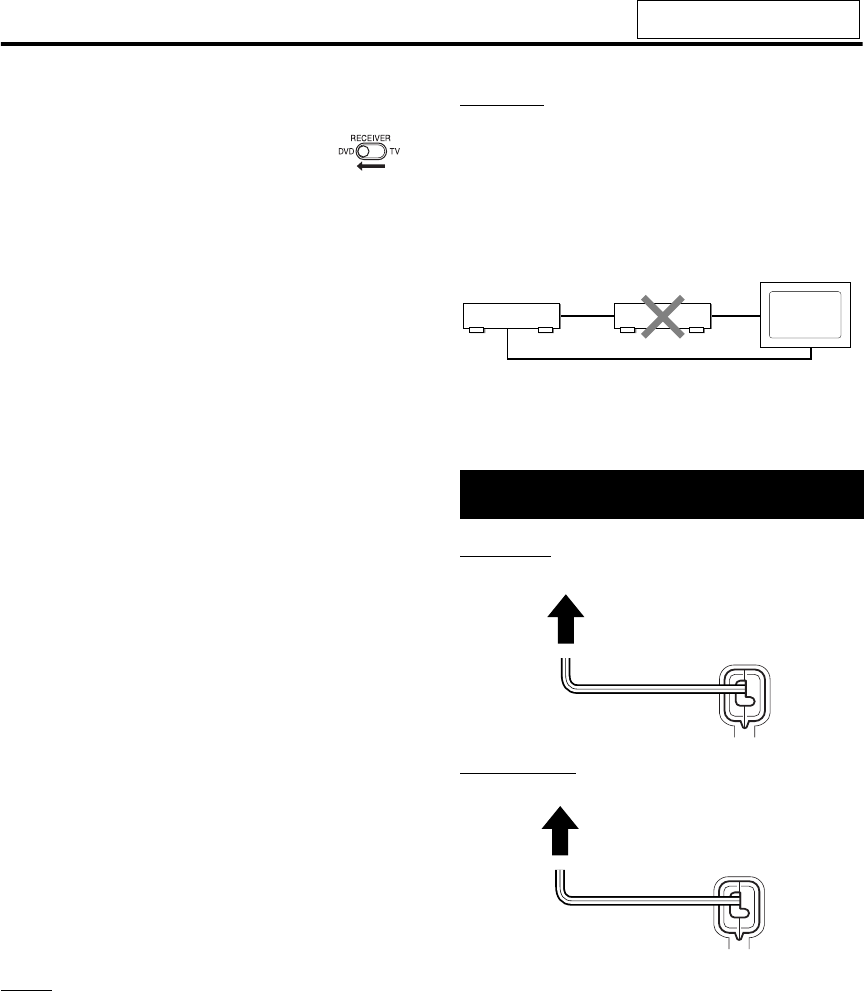
13
For the locations of the remote
control buttons, refer to page 11.
Do not turn on the power until you
complete the connection.
Connections (continued)
After connecting the DVD player to the TV, select
the video signal type correctly according to the TV.
1 Slide the remote control
mode selector to DVD.
2 Make sure that playback stops.
(If a disc is being playedd back,
press 7 to stop playback.)
3 Press SCAN MODE.
• The current video signal type will flash.
4 Press 2, 3 (cursor) to select
the video signal type suitable
for the TV.
• You can select “PAL”, “PAL PROG.”, “NTSC”
or “NTSC PROG.”. You can obtain better
picture quality in “PAL PROG.” or
“NTSC PROG.” mode than in “PAL” or
“NTSC” mode.
• Select “PAL” when a TV only compatible
with PAL interlaced video signals is
connected to the DVD player.
• Select “PAL PROG.” when a TV equipped
with a component terminal and compatible
with PAL progressive video signals is
connected to the DVD player.
• Select “NTSC” when a TV only compatible
with NTSC interlaced video signals is
connected to the DVD player.
• Select “NTSC PROG.” when a TV equipped
with a component terminal compatible with
NTSC progressive video signals is
connected to the DVD player.
5 Press ENTER.
• The selected video signal type is displayed
for a short time.
NOTE
• Although the picture may be distorted when you
press ENTER, this is not a malfunction of the
system.
• There are some progressive TVs and high-definition
TVs that are not fully compatible with this system,
resulting in an unnatural picture when playing back
a DVD VIDEO with progressive scanning. In this
case, change the scan mode to “PAL” or “NTSC ”.
• To check the compatibility of your TV, contact your
local JVC customer service center.
• All JVC-manufactured progressive TVs and high-
definition TVs are fully compatible with this system.
• Even if the power cord of the DVD player is
disconnected from the AC outlet or the power is
interrupted, the video signal type setting is stored.
CAUTION
• Do not connect an S-video cord and a
component video cord at the same time.
Otherwise pictures may not be played back
properly.
• Connect the DVD player directly to a TV (or a
monitor) without routing through a video
cassette recorder (VCR). Otherwise picture
distortion may occur during playback.
• Connecting the DVD player to a VCR-built-in-TV
may also cause picture distortion during
playback.
• Connect the power cords after you complete the
other connections.
• The STANDBY lamps on the front panels of the
receiver and the DVD player will light up.
Connecting the power cords
DVD player
DVD player
Direct connection
TV (or
monitor)
Receiver
AC outlet
Receiver
(rear panel)
AC outlet
DVD player
(rear panel)
EXA10[A_Ux]-02.fm Page 13 Tuesday, October 4, 2005 10:07 AM


















